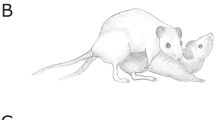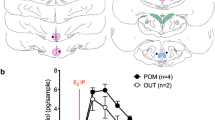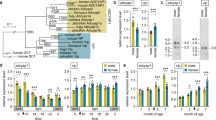Abstract
Testosterone is aromatized to oestradiol in the brain, and it has been suggested that its effects on the brain are produced by this metabolite1. Oestradiol does indeed restore sexual behaviour in castrated rats2,3, but it is much more effective if combined with a second metabolite, dihydrotestosterone4,5. This may be because the two hormones have a synergistic effect on the brain; or because the central effect of oestradiol synergises with the peripheral effects of dihydrotestosterone (which include stimulation of penile development). Evidence that the corticomedial amygdala (CMA) and the preoptic area of the rat brain are both involved in the control of sexual behaviour led us to examine the neurones of the stria terminalis that connect the two6,7. These neurones are hormone-sensitive; their absolute refractory period is lengthened by castration and reduced again by testosterone. So we have investigated the aromatization hypothesis further by examining the effect of oestradiol and dihydrotestosterone on these testosterone-sensitive neurones. Oestradiol has exactly the same effect as testosterone; dihydrotestosterone has no effect, whether it is given alone or in combination with oestradiol.
This is a preview of subscription content, access via your institution
Access options
Subscribe to this journal
Receive 51 print issues and online access
$199.00 per year
only $3.90 per issue
Buy this article
- Purchase on Springer Link
- Instant access to full article PDF
Prices may be subject to local taxes which are calculated during checkout
Similar content being viewed by others
References
Naftolin, F., Ryan, K. J. & Davies, I. J. in Subcellular Mechanisms in Reproductive Neuroendocrinology (eds Naftolin, F., Ryan, K. J. & Davies, I. J.) 347–355 (Elsevier, Amsterdam, 1976).
Södersten, P. Horm. Behav. 4, 247–256 (1973).
Paup, D. C., Mennin, S. P. & Gorski, R. A. Horm. Behav. 6, 35–46 (1975).
Baum, J. J. & Vreeburg, J. T. M. Science 182, 283–285 (1973).
Larsson, K., Södersten, P. & Beyer, C. J. Endocr. 57, 563–564 (1973).
Kendrick, K. M. & Drewett, R. F. Science 204, 877–879 (1979).
Kendrick, K. M. thesis, Univ. Durham (1979).
Keppel, G. Design and Analysis 144–145 (Prentice-Hall, New Jersey, 1973).
Hart, B. L. Physiol. Behav. 23, 107–109 (1979).
Author information
Authors and Affiliations
Rights and permissions
About this article
Cite this article
Kendrick, K., Drewett, R. Testosterone-sensitive neurones respond to oestradiol but not to dihydrotestosterone. Nature 286, 67–68 (1980). https://doi.org/10.1038/286067a0
Received:
Accepted:
Issue Date:
DOI: https://doi.org/10.1038/286067a0
This article is cited by
-
MGARP Regulates Mouse Neocortical Development via Mitochondrial Positioning
Molecular Neurobiology (2014)
Comments
By submitting a comment you agree to abide by our Terms and Community Guidelines. If you find something abusive or that does not comply with our terms or guidelines please flag it as inappropriate.



